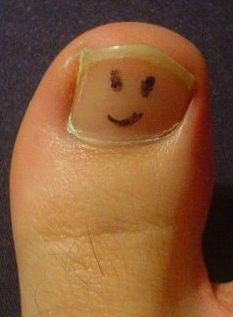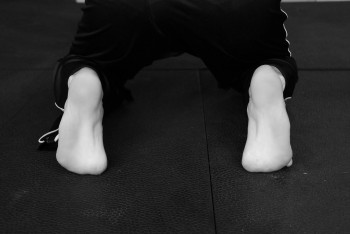The Big Toe Knows
Feb 12, 2015
 Back in early 2006, I was a physical wreck. I had severe bilateral chronic knee pain so bad, I had to lower myself onto the toilet holding on to the sink with my arms. I had torn the labrums in both hips in 2005 on separate occasions, compressed nerve roots at L4/L5, L5/S1 deadlifting in 2002, and sprained my left SI joint in 1998, and dislocated my right patella wrestling in 1989. Years of heavy lifting upon movement dysfunctions had taken its toll.
Back in early 2006, I was a physical wreck. I had severe bilateral chronic knee pain so bad, I had to lower myself onto the toilet holding on to the sink with my arms. I had torn the labrums in both hips in 2005 on separate occasions, compressed nerve roots at L4/L5, L5/S1 deadlifting in 2002, and sprained my left SI joint in 1998, and dislocated my right patella wrestling in 1989. Years of heavy lifting upon movement dysfunctions had taken its toll.I had gotten some pretty good relief from a movement system I was involved in at the time, but nothing permanent. I felt like Rocky chasing that chicken around the pen in the original Rocky movie. I could never quite get rid of it. Then, in April of 2006, in a moment of frustration with the chronic and never-ending knee pain, I bent down and slapped the floor, ending up on all fours, swearing. My feet ended up with my toes fully flexed, wedged under my ankles.
And when I stood up I was struck by the sudden absence of pain in my knees.
“Wait” - I thought to myself - “what just happened? Reverse engineer what you just did,” I told myself.
It turned out that unknowingly, I had mobilized my big toes under load, which immediately took my pain away.
How’d that work?
As physical therapist, Gary Gray pointed out, the soleus, one of the calf muscles, is a knee extensor. It attaches to the ankle and below the knee. When the foot is on the floor and the knee is flexed, the soleus is stretched. As the soleus contracts (shortens) the knee moves into extension. It stabilizes the knee from below, counteracting the forces of the quadriceps above the knee. And in order for the ankle to work properly, the joints of the toes, particularly the big toe, need to also work properly. And the muscle that attaches to underside of the big toe, the flexor hallucis longus, crosses the ankle joint, and attaches to the fibula. This, in conjunction with the soleus, work to properly transfer forces across the knee, along with the muscles on the front of the calf and back of the thigh.
Essentially, I ended up in a rocking position, with my feet dorsiflexed (toes pulled up).

Rocking, especially with the feet dorsiflexed, is one of the best ways, if not the best way, to fully restore function of the feet, ankles, knees, hips, pelvis, and reset posture, not just independently, but synchronously - that is - together, the way they’re designed to work.
The act of dorsiflexing the feet while rocking has a prying effect on the posterior hip capsules and reflexively activates the pelvic floor. This then allows the hips, pelvis, and deep abdominal musculature to operate efficiently, especially while loaded, such as in squatting or lunging, and maintain proper alignment.
The importance of mobilizing the joints of the feet (and doing so under load), especially the toes, cannot be overlooked if we want to restore our lost movement abilities. Rocking, with the feet dorsiflexed, after rocking with the feet plantarflexed (toes pointed away) is a fantastic way to restore that lost movement.
Just remember to be gentle when you first start doing this. If your toes haven’t been stretched or mobilized like this in awhile, it could be painful, especially on the big toe(s). Also remember to make sure you keep your spinal curves intact - don’t let your lower back round as you rock back just to “get a stretch” on your feet.
Am I guaranteeing or even saying that if you like me, have knee pain, that this will make your pain go away?
No.
What I am saying is that by rocking in general, and particularly doing this type of rocking, you’ll restore, or closely restore, the proper functioning of your feet, ankles, knees, hips and pelvis, among other things. In other words, you’ll move better, much better. And when these work the way they are designed, and you move better, the way you were designed, often times knee pain, which is in many cases a symptom of dysfunction elsewhere in the body, will dissipate or disappear altogether.
Give this rocking variation a shot with your resets today. I think you’ll be pleasantly surprised at how much your big toe “knows.”
Comments (0)
Please login to comment.